Newsletter: How artist Nari Ward uses castoffs to create charged worlds at Deitch gallery
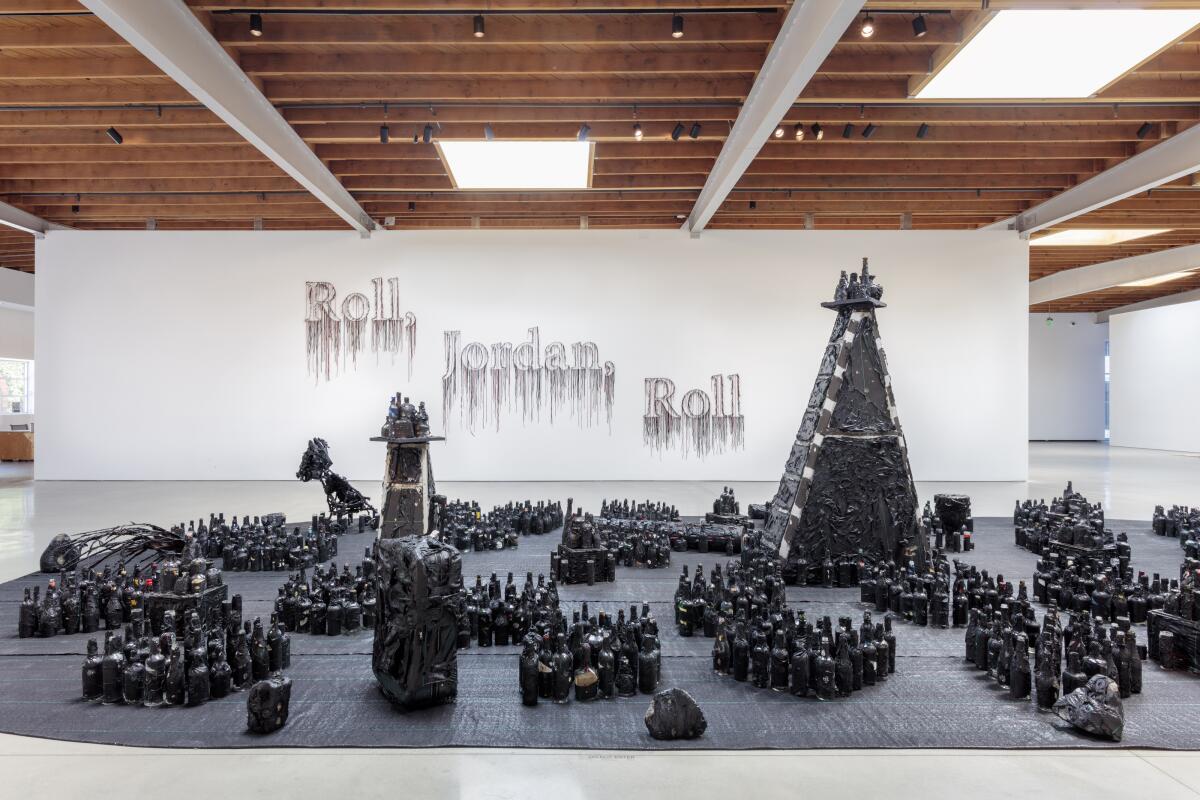
It’s Fourth of July weekend and I’ll be re-creating Little Edie’s flag dance from “Grey Gardens.” I’m Carolina A. Miranda, arts and urban design columnist for the Los Angeles Times, and I’m here bearing The Times’ weekly Essential Arts newsletter — as well as tortillas made from bronze.
Old objects seen anew
In 2013, I wandered into one of the first-floor spaces at the New Museum in New York City and was faced with a dim gallery that had been filled with hundreds of old baby strollers, all tidily arranged around the room’s perimeter, as if gathered for some important assembly. Visitors navigated the space through a lens-shaped pathway (a.k.a. the shape of a vulva) carpeted with fire hoses. The piece, titled “Amazing Grace” — after the Mahalia Jackson-version of the song that could be heard on the sound system — felt like inhabiting a womb of both birth and death. The baby carriages, evocative of infancy, told other more complex tales in their frayed and abandoned states.
The man behind that memorable installation was New York-based artist Nari Ward, who now has a solo show on view at Jeffrey Deitch in Los Angeles. “Say Can You See,” as the exhibition is titled, brings together a range of works by the artist, who fabricates his sculptures and installations from materials that can be easily harvested from junkyards, thrift stores and the street around his studio — objects that come pre-loaded with stories.
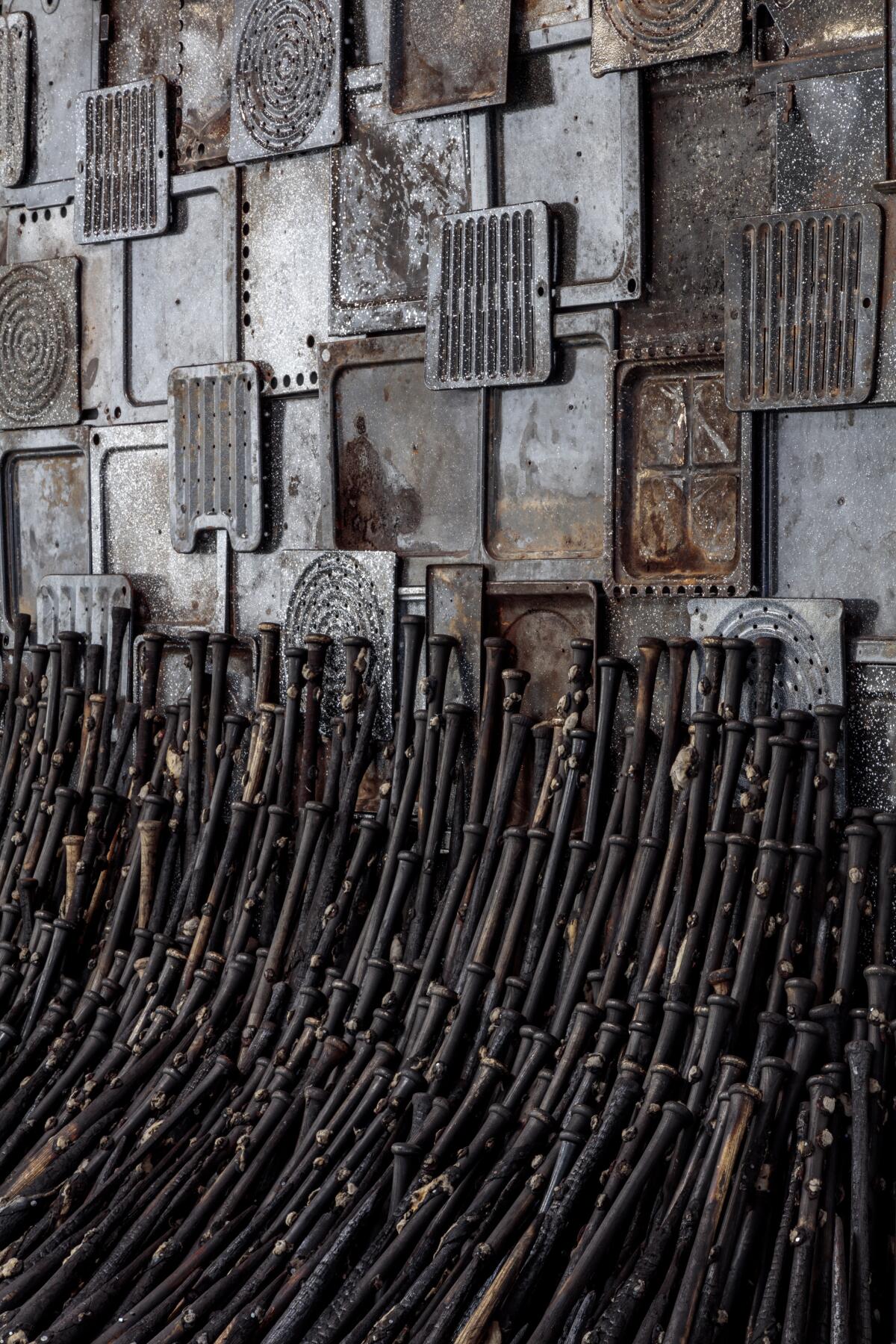
An oversized American flag appears to sparkle from a distance. Get in close, and you’ll realize that’s because it’s covered in department store sensors — the artifacts of consumerism literally weighing it down. A monochromatic assemblage, “Iron Heavens,” from 1995, is made up of broiling pans and singed baseball bats. A riff on minimalism is redolent of fires past.
As part of the exhibition, L.A.-based movement artist Jessica Emmanuel, has been staging regular performances at the gallery on Saturdays that incorporate Ward’s sculpture “Tumblehood,” 2015, a large sphere crafted out of sneakers and shoelaces, which she takes on a “journey” around the space.
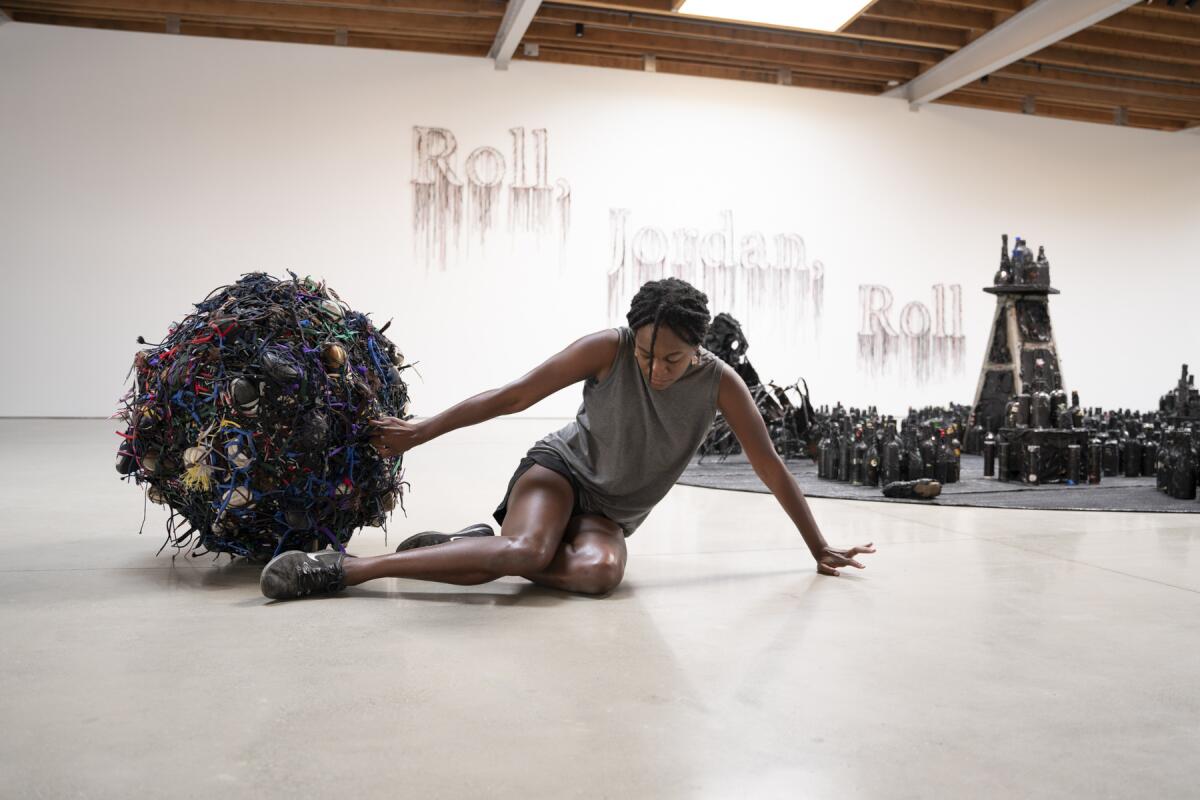
Emmanuel says that working with objects that once served another purpose evokes a lot of associations in her mind. “I start thinking about all of the shoes that go on telephone lines,” she says. “Those big piles of dollar shoes, when you’d go to that big bin. It makes me think of travel. It makes me think of community. It makes me think of the people who have come before me and the people who will come after me.”
Emmanuel both pulls and pushes the weighty piece in a loop around Deitch’s space. It’s as if, for moments, she is dragging the weight of history behind her; at others, she is propelling it into the future.
Over countless performances, Emmanuel, who recently staged the solo performance ˈkwirē/ at REDCAT, hasn’t tired of examining Ward’s work. “All of his work, the more you look at the details,” she says, “the deeper the story goes.”
Nari Ward, “Say Can You See” is on view at Jeffrey Deitch through Aug. 21. See deitch.com for hours and a schedule of Jessica Emmanuel’s performances.
And if you happen to be out and about in downtown this weekend, don’t miss Ward’s sculpture “Carpet Angel,” 1992, at MOCA Grand, on view as part of the museum’s permanent collection exhibition. You’ll have to get there soon to check it out, though. A planned reinstallation of the galleries means that the piece comes down after this weekend.
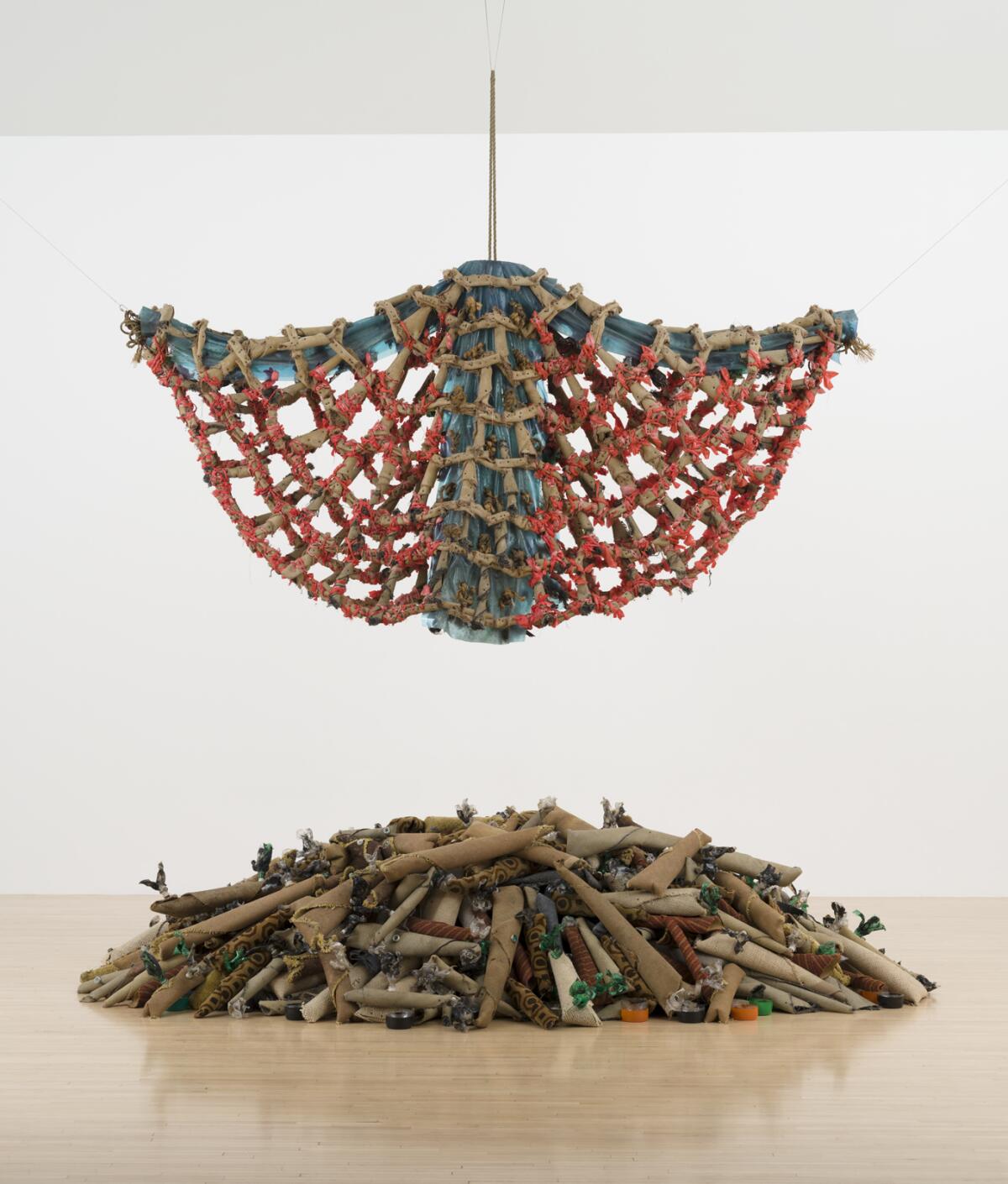
Classical notes
After 474 days, Disney Hall is back! And Times classical music critic Mark Swed was there for a performance by the Los Angeles Chamber Orchestra that kicked off with Ginastera’s “Variaciones Concertantes.” “The first notes heard again in the long-quieted Disney were a slow, soft upward harp arpeggio,” writes Swed, “each pitch a haunting, crystalline moment ringing in the air as a harp will in the hall’s illuminating acoustic, stopping a listener’s breath and time along with it — each note an eerie resonance to remember.” Also on the docket was Mendelssohn’s Fourth Symphony and a composition by young Mexican composer Juan Pablo Contreras called “Mariachitlán.”
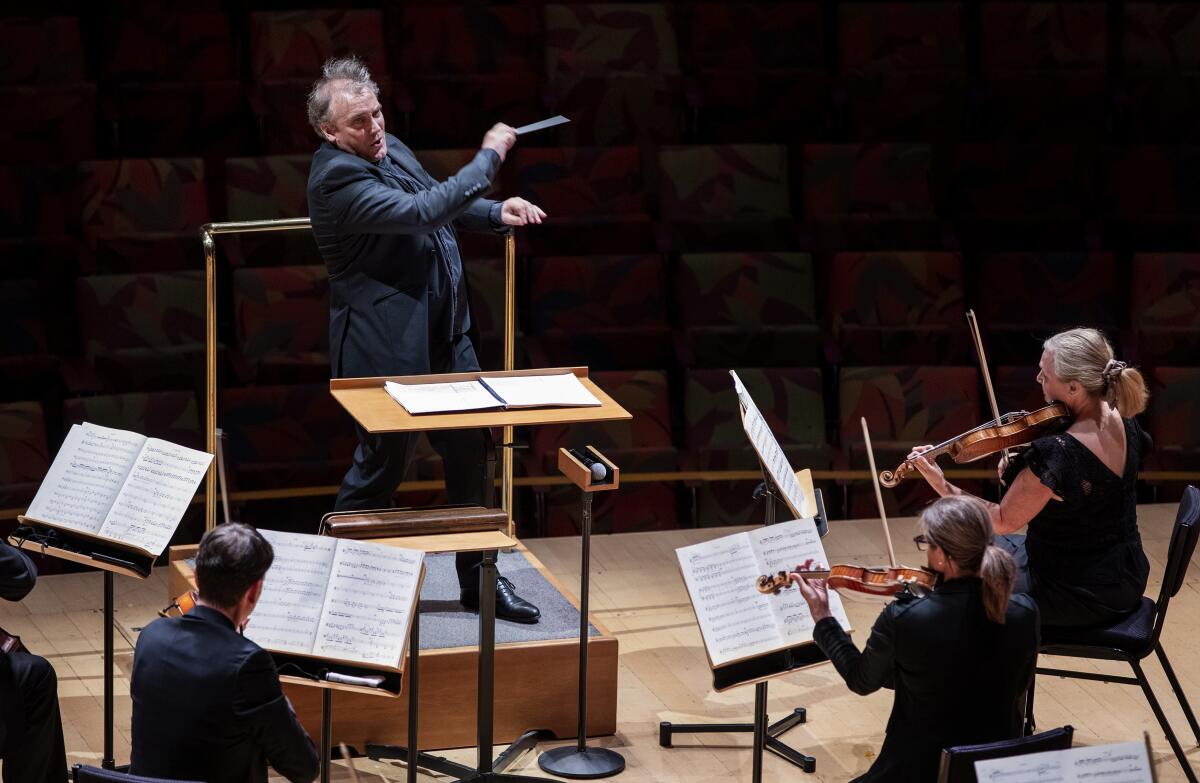
Plays and players
Playwright Torrey Townsend’s satire “Off Broadway” was intended to poke a stick at the world of nonprofit theater. But Times theater critic Charles McNulty says that this virtual show, presented by “Slave Play” author Jeremy O. Harris is “toxic in its distortions and shallowness.” He writes: “Townsend’s blunt-force lampoon fails to consider the more insidious forms of systemic abuse that run rife in supposedly enlightened cultural institutions. The ability to talk the talk while reinforcing an oppressive status quo is a tricky pattern for a dramatist to capture, and Townsend opts for broad schematic laughs over subtler comic shadings.”
Our critic was also in attendance at a staging of “Tevye in New York!,” which had its world premiere at the Wallis’ pop-up outdoor performance space in Beverly Hills. Written and performed by Tom Dugan, the show follows the central character from “Fiddler on the Roof” on his journey to New York, where he now makes a living by selling ice cream on the street. “The comedy of Dugan’s writing and delivery aren’t all that effectual,” writes McNulty. But “the mirth picks up as the storytelling kicks into gear.”
Make the most of L.A.
Get our guide to events and happenings in the SoCal arts scene. In your inbox once a week.
You may occasionally receive promotional content from the Los Angeles Times.
McNulty, who has been very busy this week, also sat down with Chris Fields, artistic director of the Echo Theater Company, on the occasion of the company’s 25th anniversary. (They are celebrating with a benefit party on Zoom that will feature 25 monologues by 25 alumni playwrights.) In their rambling discussion, Fields talks about the company’s ethos and early successes — supporting work that, as McNulty writes, is “loopy but with a gritty edge” — as well as the institutional shortcomings the pandemic and subsequent uprisings highlighted. “We faced our whiteness is what I called it,” Fields says. “We’ve been looking at our whiteness and our racial awareness in terms of our aesthetic.”
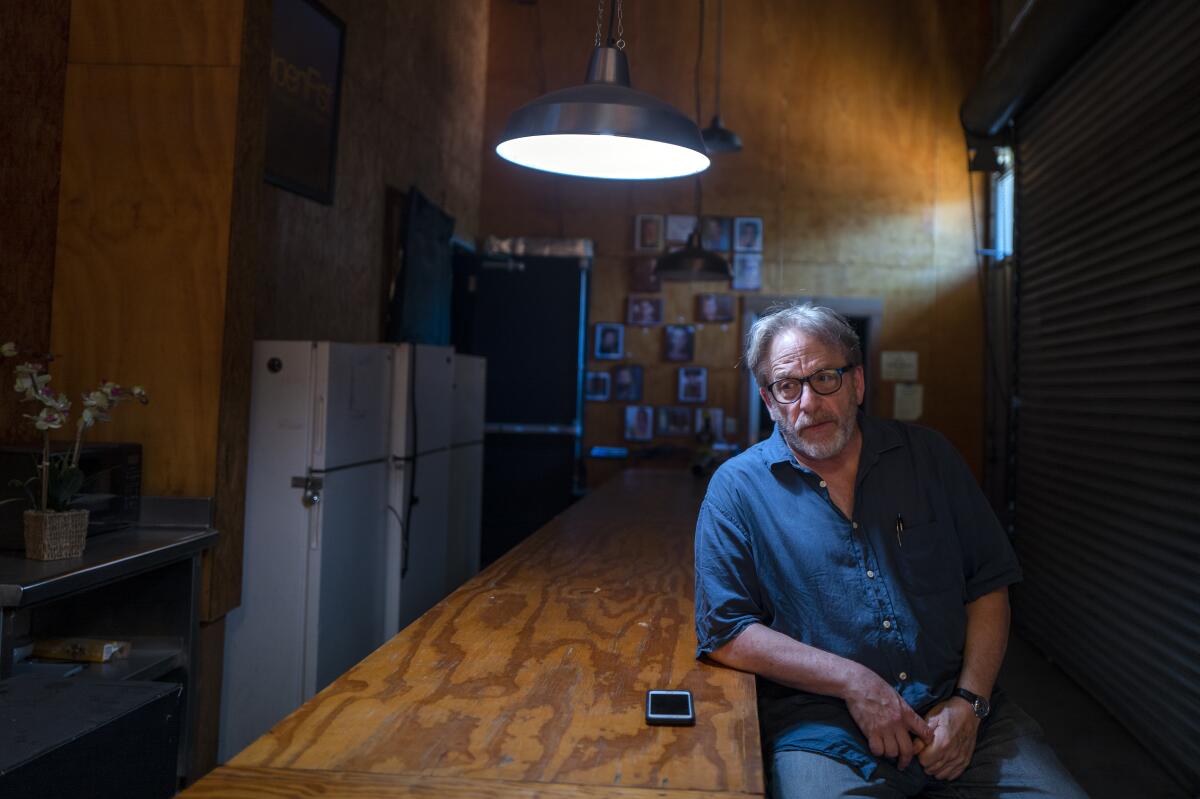
In his L.A. theater newsletter, Angeles Stage, former Times theater reporter Don Shirley argues that the next director of L.A.’s Center Theatre Group should be someone with a strong local presence: “It’s finally time for the CTG artistic director to again be someone who knows the theater ecology here firsthand, who has intensive experience in the local trenches, thinking about LA’s remarkably diverse audiences and its enormous reserves of talent.”
In the frame
There’s a Banksy show that is set to land in Los Angeles on Aug. 30, but Banksy has nothing to do with it (and has publicly expressed disgruntlement with this traveling exhibition in the past). That hasn’t in any way tempered appetite for “Banksy: Genius or Vandal,” which opens in late August and is already sold out through September. The organizers pitch it as satiating an interest in an enigmatic artist. But “others say the experience — starting at $29.50 for adults — turns art that was meant to be seen on the street, for free, into a commercial juggernaut,” reports The Times’ Deborah Vankin.
Enjoying this newsletter? Consider subscribing to the Los Angeles Times
Your support helps us deliver the news that matters most. Become a subscriber.
Speaking of art and money, Artnet critic Ben Davis writes about checking out the mini-industries that are the various Van Gogh immersive experiences. “It was the museums themselves that merchandised Van Gogh into commercialistic ubiquity, as they leaned into blockbuster Great Men of Modernism shows,” he writes. “To claim now that a public that views Van Gogh first as a great poster artist is missing the point runs contrary to what the art context itself has been teaching for decades, in the gift shop.”
Institutional updates
Deborah Vankin had a sit-down with artist and educator Catherine Opie, who will be taking over as chair of UCLA’s art department, where she has been a professor of photography for 20 years. Her priorities? Reduce student debt and the cost of an education in the arts. “The more we can create UCLA as a public institution, especially the arts as being a vital part of the city of Los Angeles, that’s the goal,” says Opie. “Can we get to the place where students are not stretched in order to have their dreams and their goals met through education?”
Across town, I chatted with outgoing Autry Museum Director Rick West, who retired this week after almost a decade at the helm. West, a citizen of the Cheyenne and Arapaho Tribes, had previously served as founding director of the National Museum of the American Indian in D.C. He told me how a career as a lawyer of Indigenous rights prepared him to lead a museum and how he has worked to shift the love-hate dynamic between Natives and museums. “Seeing Native material in a museum is inherently a false experience,” he explains. “We never put things on walls. Every object you see is associated with life and living in a Native community. You can never make a genuine gallery space in that way.”
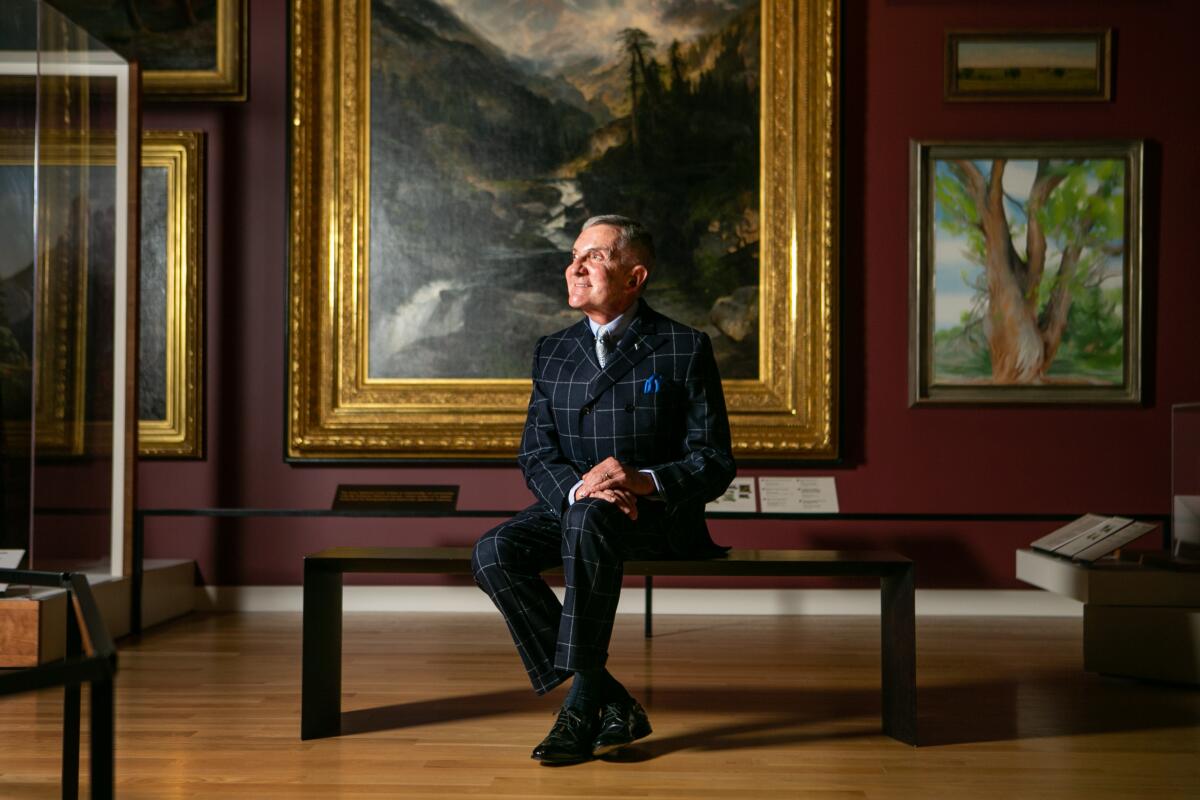
James Cuno, president and CEO of the Getty Trust, one of the country’s largest and most important arts philanthropies, an organization that supports exhibition, scholarly research and conservation activities around the world, has announced his retirement. Cuno, now 70, will step down once a successor has been selected and is in place. Cuno joined the Getty in 2011 from the the Art Institute of Chicago.
The recipients of this year’s Rabkin Prize for arts writers have been announced! They are Aruna D’Souza, John Yau, Raquel Gutierrez, Jarrett Earnest, Mark Lamster, Yinka Elujoba, Jennifer Huberdeau and Jasmine Weber.
Essential happenings
Matt Cooper rounds up the best events for the July 4 weekend, including a screening of “Jaws” in Santa Monica, an artistic installation in Grand Park and a concert of baroque music from Latin America in Sierra Madre. There will also be fireworks — and the Hollywood Bowl will be swinging with a gig by Kool & the Gang and the Hollywood Bowl Orchestra.
Cooper also rounds up everything happening in museums, including a two-part survey of works by Alison Saar at the Armory Center in Pasadena and the Benton Museum at Pomona College, as well as new and recent paintings by Jennifer Packer at MOCA Grand.
Lastly, because of COVID, this year’s C.O.L.A. grant winners do not have an in-person show at the Los Angeles Municipal Art Gallery, as is customary. But you can check out their work online. Among this year’s winners are artists Nao Bustamante, Edgar Arceneaux, Umar Rashid and Phung Huynh.
Because I’m lucky like that, I got to check out C.O.L.A. winner Ruben Ochoa’s installation as it was in progress: “Class C,” a tortilla delivery van that once belonged to Ochoa’s parents, and which he transformed into a rolling gallery back in 2001. For this show, he created a series of bronze tortilla sculptures that he displays in the space. Will some L.A. museum please install this in their courtyard?
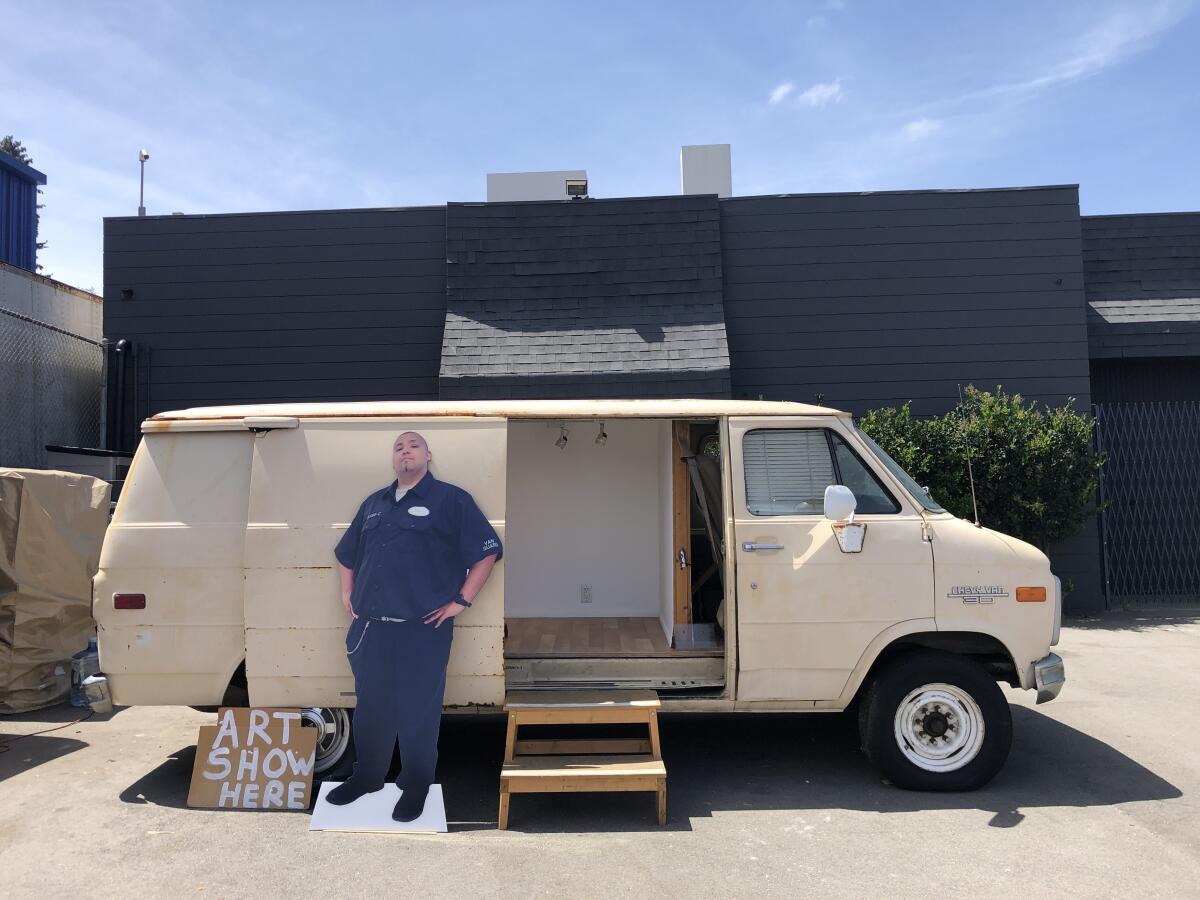
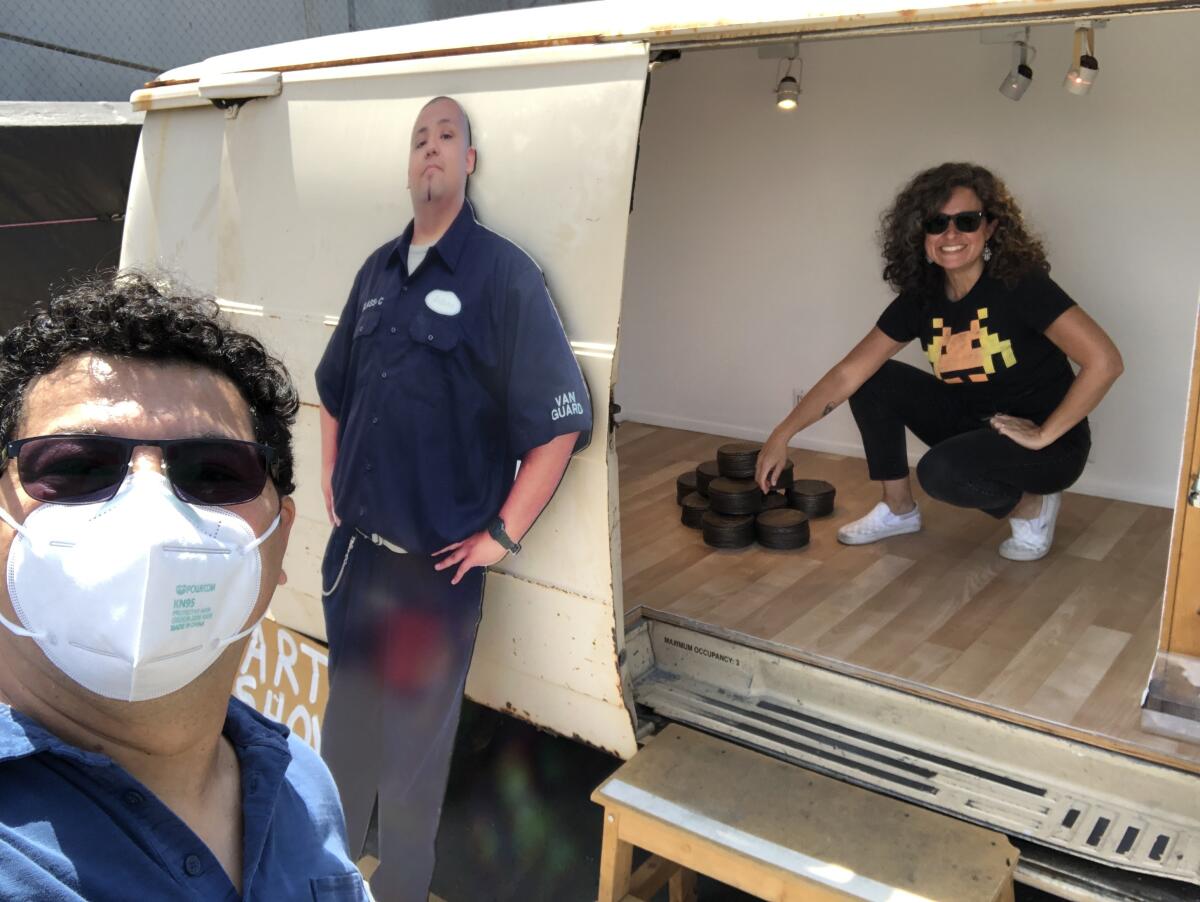
Passages
Louis Andriessen, an iconoclastic composer known for blending vernacular influences into brash works that challenged Dutch classical music’s status quo, has died at the age of 82.
Los Angeles sculptor Kenzi Shiokava, who transformed scraps of wood into totemic sculptures rife with spiritual power, is dead at 82. Shiokava, who for decades worked as a gardener (including for Marlon Brando), began his journey as a sculptor with an old railroad tie that had once supported the Angel’s Flight funicular in downtown.
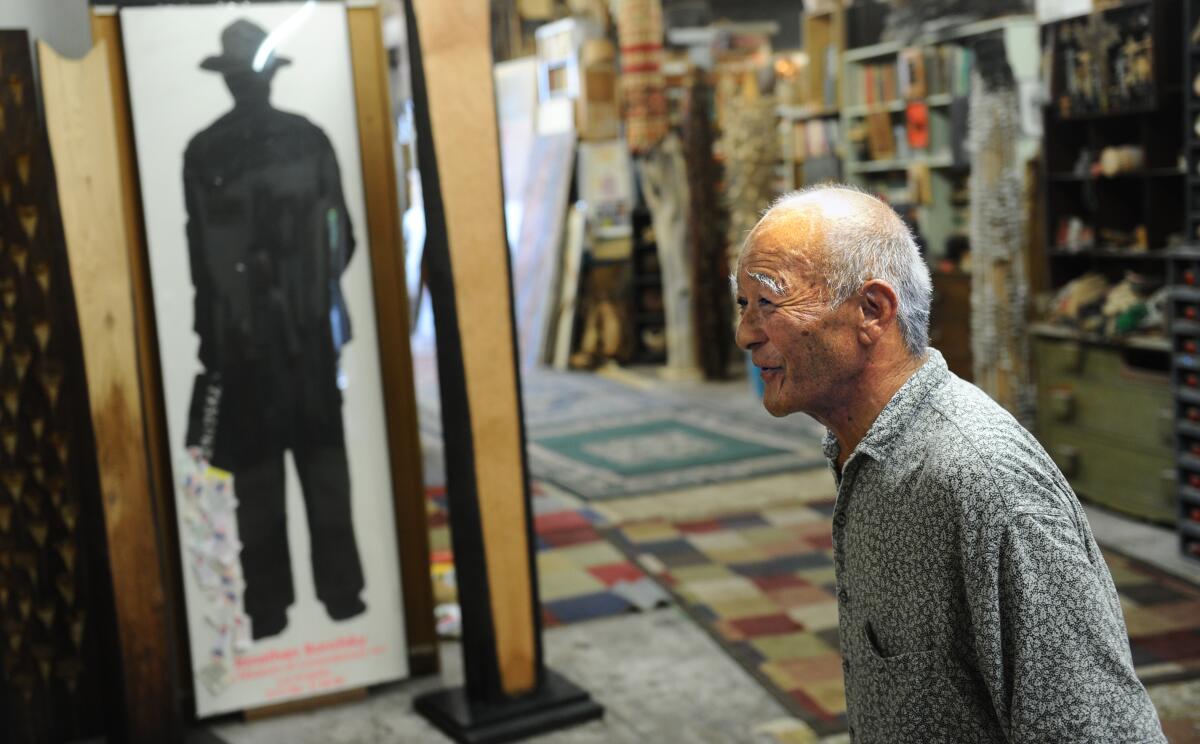
Arturo Schwarz, an influential art historian who wrote a key text on Marcel Duchamp — a two-volume book titled “The Complete Works of Marcel Duchamp” — has died at 97.
In other news
— Must-read: The cultural influence of the teen girl.
— I’ve been hanging out on Tumblr (because throwback) where I have been rather enjoying the official site for New York’s Metro Transit Authority. (You can find me here.)
— My colleague Daniel Miller reports on the phenomenon of cellphone towers dressed up as trees. As historian Kazys Varnelis says: “It is a gorilla in a tutu at the ballet.” (Be sure to watch the accompanying, very hilarious video.)
— New research from UC Berkeley shows that as cities have become more diverse, segregation remains largely unchanged.
— Bruce Springsteen is back on Broadway for a summer encore of his one-man show “Springsteen on Broadway.”
— And Kelly Tweeddale is stepping down as executive director of the San Francisco Ballet after less than two years on the job.
— There’s a new statue of the late Princess Diana by sculptor Ian Rank-Broadley at Kensington Palace. And critic Jonathan Jones is not that into it. OK, understatement. He describes it as “an uncontrolled wail of artistically absurd pathos.”
— The Washington Post has a great forensic study of the building collapse in Surfside, Fla.
— “Everywhere you look, people are either hitting deadlines or avoiding them by reading about how other people hit deadlines.” Rachel Symes writes about our deadline-minded culture, a phenomenon with which I have a fraught relationship. (If time is a flat circle, can one truly be late on a deadline? Asking for a friend.)
And last but not least ...
Terrifying and adorbz: a troop of Boston Dynamics’ Spot robots dancing to BTS.
The biggest entertainment stories
Get our big stories about Hollywood, film, television, music, arts, culture and more right in your inbox as soon as they publish.
You may occasionally receive promotional content from the Los Angeles Times.




